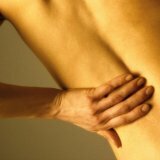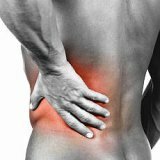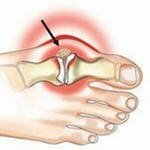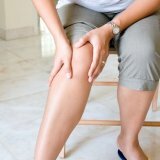Lumbosacral sciatica: symptoms, diagnosis and prevention measures
 Every second person encounters radiculitis in his life. Radiculitis can be acute or chronic. Pain usually does not require medical intervention and you can do with improvised means. However, the symptoms of sciatica in some cases are very similar to the symptoms of more serious diseases.
Every second person encounters radiculitis in his life. Radiculitis can be acute or chronic. Pain usually does not require medical intervention and you can do with improvised means. However, the symptoms of sciatica in some cases are very similar to the symptoms of more serious diseases.
A very common disease is lumbosacral radiculitis. Symptoms, diagnostics and preventive measures should be known to everyone.
Lumbosacral sciatica is a common name for pain caused by irritation or compression of the sciatic nerve. In another way, lumbosacral radiculitis is called sciatica.
The sciatic nerve is the longest nerve in our body. It goes from the back of the pelvis, passes through the buttocks, descends to the legs and ends at them.
When something compresses or irritates the sciatic nerve, it causes severe pain, which spreads from the lower back and descends to the legs. Pain in the sciatic nerve can vary greatly in pain.
The main cause of sciatica are herniated intervertebral discs. They in most cases cause inflammation of the nerve.
Types of lumbosacral radiculitis.
There are two types of radiculitis: acute and chronic. Acute lumbosacral radicitis lasts up to six weeks. Chronic radiculitis lasts much longer. They, as a rule, appear to old age and remain with the person until the end of life.
Most cases of acute radiculitis occur without the need for treatment. Symptoms make it easier to combine self-help measures. Here you can include taking painkillers: internal and external. Also performing a number of physical exercises, cold and hot compresses. All this should help relieve pain.
In the case of chronic radiculitis, a structured exercise program can be advised under the guidance of an experienced physiotherapist. In rare cases, surgical intervention is required to relieve symptoms.
It is difficult to make any predictions in case of pain in the sciatic nerve.
Most people claim that sciatic pain passes naturally for several days or weeks. Nevertheless, it is worth to visit your local doctor in several cases.
First, medical supervision is necessary if you have other symptoms other than pain in the back and legs. This can be weight loss or bladder or bowel incontinence.
Of course, go for an inspection should be if the pain is unbearable and bring a lot of discomfort. Not all cases manage to cope with the pain yourself.
There are cases when pain similar to sciatica is caused by a completely different cause. The problem can be very serious. Symptoms of sciatica.
Sciatica is different from general back pain. Pain from the sciatica is localized only in the lower part of the back and buttocks. She can give in one or both legs, up to the calves.
Pains in the sciatic nerve range from mild to very painful and can last for several weeks or months.
If your diagnosis is radiculitis, then you may encounter other symptoms. They are usually localized around your feet and feet and appear as tingling, numbness. You can feel muscle weakness and loss of tendon reflexes.
Causes of radiculitis.
Shift of vertebral discs or in other words a hernia is one of the most common causes of sciatica nerve inflammation.
Your spine consists of vertebrae, discs and nerves. The vertebrae are surrounded by a bone structure that makes up the backbone and protects the nerves from damage.
Flexibility of the spine is possible thanks to the vertebral disks. They consist of a rigid fibrous tissue and are in a dense jelly-like substance. In the case when the outer part of the spinal disc is broken, the intervertebral gel penetrates inside. There is pressure on the sciatic nerve, which can cause its inflammation.
With age, vertebral discs become more rigid and brittle. Their elasticity is significantly reduced. Loads on the back can lead to their damage and cause sciatica.
Vertebral hernia is not the only cause of lumbosacral radiculitis. Another common cause is stenosis. This narrowing of the nerve passages in the spine. Stenosis manifests itself only in older people. It is caused by age-related changes in the spine and ligaments of the spine. The cause may be bone disease, such as Paget's disease.
Less commonly, lumbosacral sciatica can be caused by infection or trauma. The cause may be the growth of the tumor within the spine.
If the symptoms of sciatica are weak and do not last longer than six weeks, the medical intervention disease usually does not require.
Diagnosis of sciatica.
There are several tests and techniques that can confirm the presence of sciatica nerve inflammation. The simplest test is to lift the elongated leg out of the horizontal position. If this procedure causes severe pain, then this is a sign of inflammation.
The cause of pain can become clear to the doctor after studying your medical history. Feel free to elaborate on all individual circumstances. The doctor must be sure that the cause of radiculitis is not a serious illness, for example, infection of the spine, ponytail or cancer.
Symptoms that suggest the presence of horse tail syndrome are numbness, lack of control over the bladder or intestines, weakness in the legs. These are atypical symptoms for radiculitis.
Symptoms that suggest cancer or infection:
Your age is over 50 years old and you have never had back pain
Your medical history includes cancer
- You have symptoms such as fever, chills, cutting weight loss
- you have hadUrinary tract infections
- You use narcotic drugs
- you have structural deformity of the spine
If you have any of these symptoms, then you will need further observation. You will be assigned blood tests. This is important to exclude the presence of infection.
The usual procedure is an MRI.Using strong magnetic waves, the device creates a detailed picture of your spine. MRI allows you to identify any problems with the nerves and structure of the spine.
Prevention of sciatica.
One of the main causes of back injury, especially at work, is the sudden lifting of weights. The study of the correct method of lifting and transporting goods can prevent the appearance of radiculitis.
Think again, before lifting heavy loads. Maybe it's worth taking a lift or a lift?



